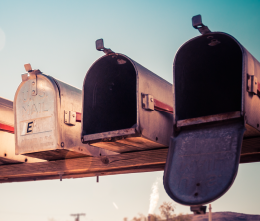
Tracking Delivery Failures
When you run a large operation or business, it’s just as important to know what isn’t getting done as well as what is. This very much applies to the U.S. Postal Service regarding its more than 233,000 delivery routes across the country.
The Postal Service is charged with delivering mail to every address on those routes six days a week. In fiscal year 2022, total volume of delivered mail was more than 127 billion individual pieces — letters, packages, periodicals, and more.
Sometimes, however, a route goes undelivered or partially delivered. On an undelivered route, no homes or businesses receive their regular daily delivery; on a partially delivered route, only some customers experience no delivery. Various reasons can be the cause — severe weather, for instance, or unavailability of carriers.
We recently looked at the Postal Service’s management of undelivered and partially delivered routes and found the agency has tools that identify delayed mail on routes, but the tools don’t identify the number of undelivered and partially delivered routes nationally. As we note in our recent audit report, one tool estimates potential route and delivery point failures but can’t identify undelivered routes.
We did, however, find opportunities for USPS to leverage existing tools and technologies to identify the actual number of undelivered and partially delivered routes. For example, the Postal Service could integrate delivery operations data with Informed Delivery. Also, data on delayed mail and undelivered and partially delivered routes could be used to notify customers of delays and service outages in near real-time. Notification of service interruptions is important to provide world-class, universal mail service.
Are there other areas where the Postal Service needs more management tools? Let us know in the comments below.

Leave a Comment
Those of us who rely exclusively upon Post Office Boxes for deliveries are at a disadvantage regarding parcels.
Many businesses, most of them small, choose to utilize the less expensive SmartPost and SurePost services.
Their online ordering systems will not accept PO Box addresses. When our local stations receive parcels for addresses having no roadside mail receptacle, they are returned to the sender. By fully utilizing today's relational database management systems, this problem can be resolved.
.
Why? Because there are a lot of services today that will not ship or mail to a PO Box, and the local carriers are constantly changing positions and routes, which means if you train your local carrier what to do with your mail and they leave you have to start over again, if you even see the local carrier.
I've been told to just put the street address in with a second line that says Unit # (your PO Box # here). Sometimes this works, but again, if the new worker at the local office doesn't know what it means and hasn't been properly trained you don't get your mail.
In the past year, I've had several items returned because the carrier marked the mail with no mailbox and sent it back, or it was put in one of my neighbor's boxes and I never got it, but it wasn't returned either, or I get "I don't know, it was a new driver, or some other answer that doesn't help one iota.
With technology being what it is today, why can the USPS not tie a physical address to a PO Box, instead of forcing people to put up mailboxes that are completely insecure and take even further risk.
For instance just today, I received 3 parts of a 4 part order that originated in Ontario Canada via DHL. DHL does not deliver to the state of TN, so they take it to Greensboro, NC and hand it off to USPS, which is where the problem lies. DHL won't ship to a PO Box, so the street address has to be used, then the shipment is handed off to USPS who is incapable of delivering a package addressed to the street address if the receiver chooses the more costly and secure method of a PO Box.
Cannot someone in the federal government get this straight?